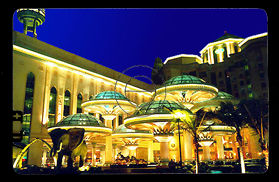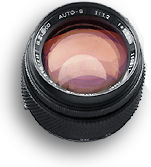The standard lenses, other than being termed as "standard", these lenses are probably also the most sellable among all optics. Not because it is special in terms of usage or technical aspect but rather due to policy created by manufacturers to sell a new SLR camera model bundled along with a standard lens. Most retailers were also happy complying with such unofficial rule of thumb for making first time SLR buyer paid for such path of growth during those prime days of all manual focus SLR photography.
 |
Sunway Resort Hotel, Malaysia ... (63k Jpeg View) A beautiful night scene at entrance of the anchor hotel for the exotic mining pool turned holiday resort, Sunway Lagoon theme park. Fast lens speed reduces exposure time required for such shots. Naturally, you would need a steady tripod to minimize camera movement to register crystal clear details. Warm color temperature created with daylight film also helped to project a sense warmth which supplements a good traveled shot like this photograph. |
The standard lenses at these focal
lengths, are often neglected as a lens capable of complementing a photographer's
imagination. Personally, I would rate these lenses as the easiest to use but the
MOST difficult to master among all focal lengths. Compared with other focal length
lenses, these lenses does not project unusual characteristics into the image - it
remains essentially faithful to the human vision because its angle of view projects
inside a SLR is somehow close of how a human vision conceives.
 |
During those days, 50mm standard lenses are the best selling and also the cheapest within a specific lens family of any brands. These optics also offer superior optical performance and is often referred to as the respective company's reference lens to exhibiting their best in optical design and quality. |
During the early years, a standard lens is often used to gauge and review a new camera model, and thus a lot of research has been conducted to ensure its high performances. Generally, the standard 50mm focal length has the fastest lens speed among all lenses in any particular lens family - other than third party manufacturers which do not seemed to provide any option in this class.
Why is the 50 mm
lens is referred to as the "standard" lens?
Aside from the fact it was customarily accompany most 35mm SLR cameras on purchase,
there are several other reasons:
One acceptable theory is that lenses of these type with its ' focal length closest
matches to the 43.2 mm diagonal of the 35 mm camera's 24 x 36 mm picture frame.
Another is that its field of coverage (40° horizontally, 46° diagonally)
is roughly equal to what one human eye can view with relative clarity. Simply,
the 50 mm standard lens projects a similar coverage to that of how we 'see' things
and 'reproducing' an image of a particular given scene. Naturally, in this respect,
its advantage is also its biggest drawback especially to a photographer who may find
find this type of "truthful reproduction" too common in terms of creativeness
and started to resort on lenses of other types that can provide more dramatic visual
impressions such as those can alter perspectives like telephotos or wideangles etc.
 |
Among the many distinguish features in any standard 50mm lenses, they usually have the fastest lens speed in a particular lens family. When blending with modern fine grained high speed ISO film, these bright lenses would be the ideal choice to help you handle any photographic assignment that may need to work in very low available light level. An additional characteristic of fast lenses is you can have more control over depth of field generates via the large maximum apertures. |
<<<<<----- A typical Olympus Zuiko 50mm f1.4 weighs only 230g (8.1 oz) and measures mere 40mm in length. Older version G-Zuiko AUTO-W 50mm f/1.4 is even shorter at 37mm !
An practical application for a standard lens is, Instead of assuming that the standard lens can only take normal pictures, always think of it as a short telephoto lens. Since it is the only lens which lies between the two types between wide angles and telephoto lenses. |
If you can fine tuned your mind
to have a different perception towards this lens, it can be the best lens to study
basic photographic techniques. After the photographer has completely mastered this
lens, he or she can safely move on to the super wide-angles, wide-angles, telephotos,
super telephotos, macros and zoom lenses, with the added knowledge of what how these
lenses of different focal length would affect angular view fields and varying perspectives.
I always think any new photographic enthusiast should use this 'conventional approach'
to start off SLR photography. But nowadays, it is hard to convince anyone especially
when they are being constantly influenced by commercials/advertisement to invest
into zoom lenses first. Well, you may have never experienced how to persuade someone
to start off with a standard 50mm lens, believe me, I did this many times and have
never succeeded. Only the "veterans" who have gone through all those painful
experiences will understand what I meant.

By the way, Olympus has a few options at this focal length, each comes with a different optical characteristic in their lens speed and optical design to suit one's budget and requirements. They are the Zuiko 50mm f1.2, Zuiko 50mm f1.4, Zuiko 50mm f1.8 and a specialized close-up lens of Zuiko MACRO 50mm f/3.5. Naturally, you also can use all those earlier versions of 50mm Zuiko lenses such as G-Zuiko AUTO-S 55mm f/1.2, G-Zuiko AUTO-S 50mm f/1.4, F-Zuiko AUTO-S 50mm f/1.8 and along with a Zuiko AUTO-MACRO 50mm f/3.5.
I am not sure when Olympus dropped the older 55mm f/1.2 and replaced it with a 50mm version. But both lenses exhibit, other than the colour of the reflectance of coating with the front element, almost similar physical appearance except when you measured them. The new Zuiko 50mm f/1.2 weighs 285g and measures 43mm in length, while the older 55mm lens weighs heavier at 310g and measures longer at 47mm. Anyway, the filter size for the 55mm lens is 55mm but the newer version takes popular 49mm filter accessories.
Olympus Standard Lens: Zuiko 50 mm f/1.2
 |
A completely redesigned lens with revised lens construction enables the lens to be much compact than earlier version which takes 55mm filters. The new lens is shorter in length as well as reducing the weight down to 285g and accept popular OM 49mm filter accessories. |
Contrast and various aberrations that would affect image quality common to lenses with such large aperture are well contain and corrected. Despite not incorporating a floating element system, it is still able to close focus at 0.45m while maintaining high optical performance.
A lens that was specially produced to perform in low light, maximum aperture situations, critical selection of optical glass and the proper use of multi-film coating techniques have improved the spectral transmission factor and reduced ghost images which may be common in low available light photography.
| Specification: Focal length: 50mm Aperture ratio: 1:1.2 Lens construction: 6 groups, 7 elements Angle of view: Diagonal: 46° Distance Scale: (m) 0.45 to infinity (oo) Focusing: Helicoid Minimum aperture: f/16 Diaphragm: Automatic Filter Size. 49mm Length x max. diameter: 43mm Weight: 285g (10.1oz) |
 |
Type: G-Zuiko AUTO-S
55mm f/1.2 Focal length: 55mm Aperture ratio: 1:1.2 Lens construction: 6 groups, 7 elements Angle of view: Diagonal: 43° Distance Scale: (m) 0.45 to infinity (oo) Focusing: Helicoid Minimum aperture: f/16 Diaphragm: Automatic Filter Size. 55mm Length x max. diameter: 47mm Weight: 310g (10.9oz) |
JUST how compact are the Zuikos compared with rivaling Japanese 35mm manufacturers ? Just to satisfy my curiosity, I took a picture of the various 50mm lenses f/1.4 of other makes and compared with the older Zuiko 55mm f/1.2 lens and surprisingly to find it is not any larger than any one of them despite it has a relatively faster lens speed.
 |
 |
 |
 |
Far left: Zuiko 55mm f/1.2, Canon FD 50mm f/1.4 S.S.C.; Nikkor AI-S 50mm f/1.4 and a Canon FDn 50mm f/1.4. Naturally, the newer Zuiko f/1.2 lens is even smaller than all of those featured here. Credit: Mr. Lim and Ms Jennie of FOTO Edar for their generosity for lending me their Zuiko f/1.2 lens for this shot.
|
Previous | Next
| 1/3 To ensure you have a nice browsing
experience without waiting for excessive download time, subsequent 50mm pages are
separate into another page.
Next, the two moderately high speed but very popular lens of Zuiko 50mm f/1.4 and
Zuiko 50mm f/1.8